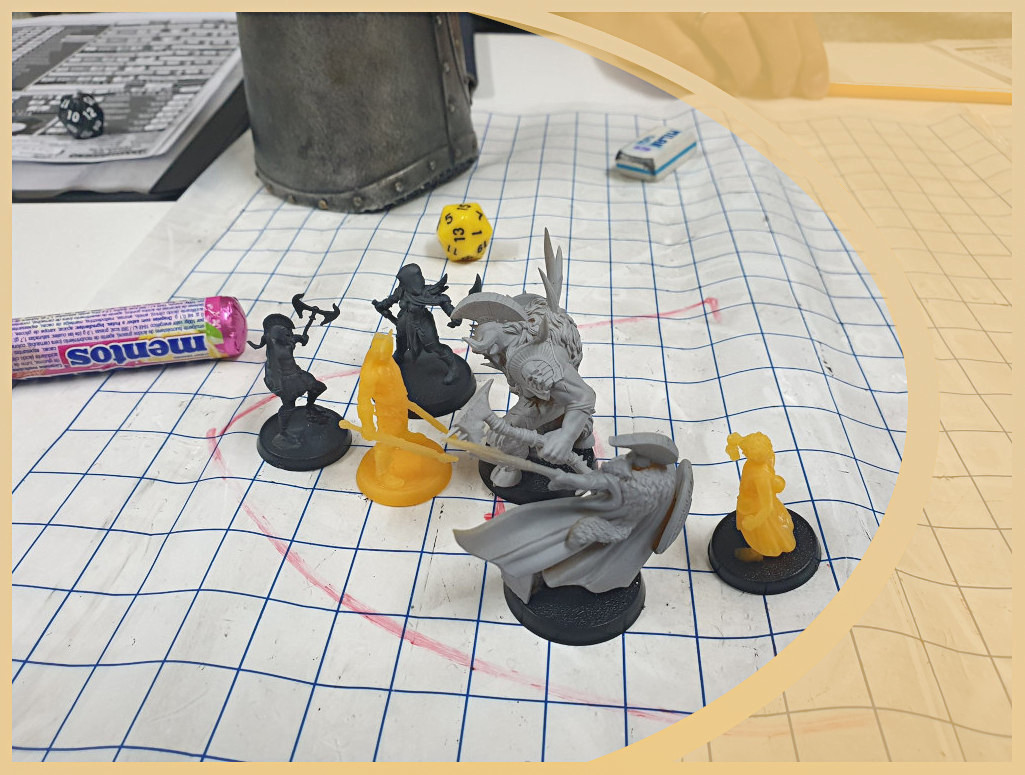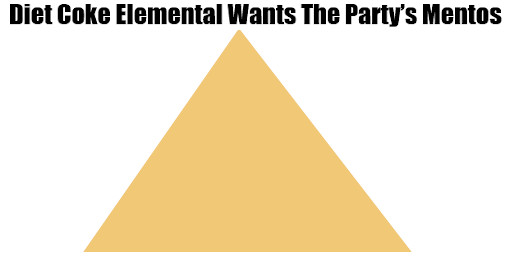While scrolling through #Pathfinder2e on Twitter, I came across the above pic Caballeros Templados (@CTemplados) Tweeted. The account posts in Spanish, so at first, I hesitated posting a quick joke in English, having grown up in a culture where speaking the wrong language can be fighting words. But I hoped gaming proved to be a universal language and went ahead with my reply, “Defend the mentos!!!”
I’m glad I did, because Caballeros Templados turned out to be at least bilingual, which lead to this exchange:
Which inspired today’s article.
Bottom-Up vs Top-Down
Ah, it’s been a while since I’ve described the difference between bottom-up and top-down, a staple of early episodes of 3.5 Private Sanctuary. I’m not even sure why, I just know it came up a lot.
In top-down planning, you start with a goal and need to figure out a way to get there. In bottom-up planning, you know where you are and need to figure out where you need to go before you can figure out how to get there. “I’m making a leek and potato pie” is top down. You have your meal, now gather your ingredients and get a recipe. “I need to make something with this leek and these potatoes,” is bottom up. You have your ingredients, but you need a meal idea before you can figure out your recipe.
Going back to my Twitter thread with Caballeros Templados, his pic with the Mentos and comment about Diet Coke conjured a strong visual of a silver, white, and red volcano erupting brown lava. As I often do, my fellow GMs, I asked myself “How do I turn the emotions I’m experiencing into something for my players?” Which, obviously, brought me to a Diet Coke Elemental trying to get to the party’s Mentos.
In a way, I had a top-down problem. I knew what kind of encounter I wanted, now I needed to build it.
Except, I’m not actually giving the party Mentos loot and creating a sugar free cola elemental. I had aspects that I knew could be an encounter, now I needed to figure out what that encounter would look like. Or, graphically:
Normally, they’re presented as binary options. You have a goal but no path, or a path with no goal. But what about middle out design?
Middle-Out
I just Googled it and discovered middle out is totally a thing already, by that name and everything. In that case, I’ll let Forecasting: Principles and Practice (2nd ed) by Rob J Hyndman and George Athanasopoulos define the idea:
The middle-out approach combines bottom-up and top-down approaches. First, a “middle level” is chosen and forecasts are generated for all the series at this level. For the series above the middle level, coherent forecasts are generated using the bottom-up approach by aggregating the “middle-level” forecasts upwards.
In the case of Diet Coke Elemental Wants The Party’s Mentos, our graphic looks like this:
Designing From The Middle
The middle is an excellent place to design from. As the graphic indicates, the idea has layers. It’s not just an idea that needs to be build to, or components that need to add up to a whole. You need to build the components before you can build your idea.
Find Your Middle
Middle-out design starts with an original idea. It’s not “I want a dragon encounter, what are my options?” or “Oooh, I like this dragon. What kind of encounter could I build with this?” It’s “Dragon who hoards dragon bones,” “Dragon thinks humans only speak in riddles,” or “Dragon with a guitar?” An idea that is neither the beginning nor the end, but the end of the beginning.
Up, Down or Both?
Now that you’ve found your middle, look around. In one direction, you have everything your idea could be. In the other direction, you’re blinded by how polished your idea can become. Don’t move on too quickly. Bask in your options.
Looking Down
Looking down expands your options. You know the Diet Coke Elemental wants the party’s Mentos, but what does that mean? Well, we need rules for our monster, rules for our item, rules for the two interacting, and rules for the PCs figuring out what happens when the two interact. We don’t want them to look back on the monster and the item after the fact and only then understand why the interaction happened. We want the thrill of keeping the two apart during the encounter as interesting as the consequences of the two coming together.
Looking Up
Looking up hones in on the specifics. You bought the Lego kit for the finished product, what’s the finished product look like. As I said in the Tweet, “I’ll probably skin it as an oil elemental trying to get their torches or something.” Looking up, I realize that an actual Diet Coke Elemental and Mentos would derail the campaign, I need to shed the silliness of the idea, but keep the drama.
Looking Back and Forth
Although you can decide your idea needs polishing before you can build it (going from the middle to the top then working down), or see what exciting toys fit with your idea before deciding what you want to do with it (going from the middle to the bottom then working up), you can also make a little progress in both directions.
- *looks up* I know the Diet Coke Elemental wants the party’s Mentos, and I know I want a less silly version of that idea, so what are my options?
- *looks down* An oil elemental. But what is that? Maybe a water elemental that’s not resistant to fire but, in fact, becomes a fire elemental when it interacts with fire.
- *looks up* The oil version needs to be a threat to the party to survive long enough for the “keep away” gimmick to play out, but the fire elemental needs to be a greater threat to the party to make the elemental catching fire to be a bad thing for the party.
- *looks down* Water elementals have Fast Healing while underwater, so if the oil elemental is a water elemental of Party Level +1 and gets the situational fast healing, that makes it moderate threat. Catching fire makes it a Party Level +2 fire elemental but without the situational fast healing, making it still a moderate threat, trading off a defensive ability for an overall increase in effectiveness. Ooh, or three Party Level -2 water elementals that become Party Level -1 or Party Level fire elementals, so we can have our gimmick go off once or twice and the PCs can still feel like they kept the situation from getting worse.
- *looks up* We need to guarantee the PCs have fire, and that they can keep it away from the oil elemental.
- *looks down* Have a passage blocked by oily webs that temporarily dull any weapons used to cut them, but can be burned in no time. Then have dangling fires in the next room, with the oil elemental encounter, whether the PCs have fiery torches or not. And since 2e elementals can take any shape, justify the oily webs by make the elementals spidery.
And there we have our Diet Coke Elemental wants the PCs’ Mentos encounter, without a Diet Coke Elemental or Mentos.
Weirdly, this is the second time I’ve improvised a fire spider recently.
Every two weeks, Ryan Costello uses his experience as a Game Master, infused with popular culture references, to share his thoughts on best GMing practices to help his fellow GMs. Often deconstructing conventional wisdom and oft repeated GMing advice, he reminds his fellow GMs that different players play the game in different ways, and for different reasons.










